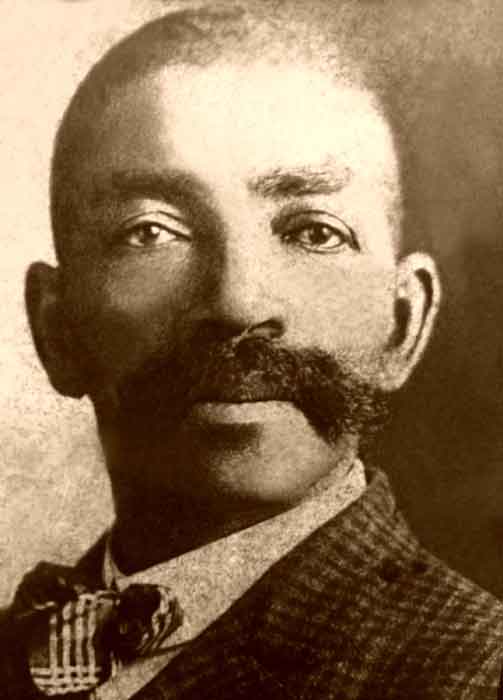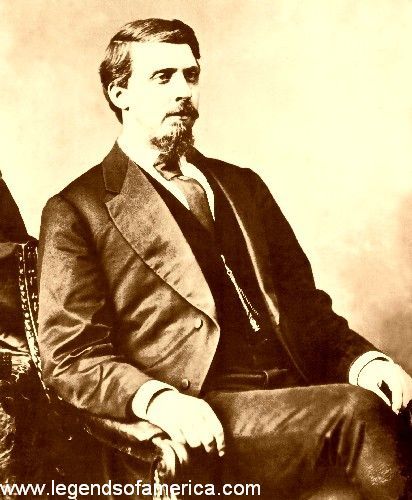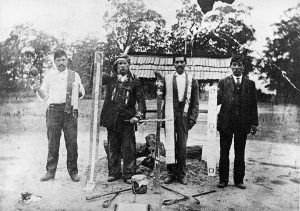“Maybe the law ain’t perfect, but it’s the only one we got, and without it, we got nuthin.”
— Bass Reeves.
Born to slave parents in 1838 in Crawford County, Arkansas, Bass Reeves would become the first black U.S. Deputy Marshal west of the Mississippi River and one of the greatest frontier heroes in our nation’s history.
Owned by a man named William Reeves, a farmer and politician, Bass took the surname of his owner, like other slaves of the time. His first name came from his grandfather, Basse Washington.
Reeves started as a water boy until he was old enough to become a field hand, working alongside his parents. In about 1846, William Reeves moved his operations, family, and slaves to Grayson County, Texas.
Bass was a tall young man, at 6’2″, with good manners and a sense of humor. William’s son, George Reeves, became his valet, bodyguard, and companion. When the Civil War broke out, Texas sided with the Confederacy, and George Reeves went into battle, taking Bass with him.
During the years of the Civil War, Bass and Reeves parted ways. Some say this was due to Bass beating up George after a dispute over a card game, while others believe that Bass fled after hearing too much about the “freeing of slaves.” Regardless of the reason, Bass escaped to Indian Territory (now Oklahoma), where he found refuge with the Seminole, Cherokee, and Creek Indians. There, he learned their customs, languages, and tracking skills. He also sharpened his firearm skills, becoming quick and accurate with a pistol. Although Reeves claimed to be “only fair” with a rifle, he was routinely barred from competitive turkey shoots.
“Freed” by the Emancipation Proclamation in 1863 and no longer a fugitive, Reeves left Indian Territory and bought land near Van Buren, Arkansas, where he became a prosperous farmer and rancher. A year later, he married Nellie Jennie from Texas and immediately began to have a family. Raising ten children on their homestead — five girls and five boys, the family lived happily on the farm. During this time, oral history states that Reeves sometimes served as a scout and guide for U.S. Deputy Marshals going into Indian Territory on business for the Van Buren Federal Court, which had jurisdiction over Indian Territory.
Reeve’s life as a contented farmer would change when the Federal Western District Court was moved to Fort Smith, Arkansas, and Isaac C. Parker was appointed on May 10, 1875. At that time, the Indian Territory had become exceptionally lawless as thieves and murderers, and anyone wishing to hide from the law took refuge in the territory that previously had no federal or state jurisdiction.
One of Parker’s first official acts was to appoint U.S. Marshal James F. Fagan as head of some 200 deputies he was then told to hire. Fagan heard of Bass Reeves’ significant knowledge of the area and his ability to speak several tribal languages, and he was soon recruited as a U.S. deputy.
The deputies were tasked with “cleaning up” Indian Territory and, on Judge Parker’s orders, “Bring them in alive — or dead!”
Working among other lawmen who would also become legendary, such as Heck Thomas, Bud Ledbetter, and Bill Tilghman, Reeves began to ride the Oklahoma range in search of outlaws. Covering some 75,000 square miles, the United States Court at Fort Smith was the largest in the nation.
Depending on the outlaws he was searching for, a deputy would generally take a wagon, a cook, and a Native American posseman from Fort Smith with him. They often rode to places like Fort Reno, Fort Sill, and Anadarko, a round trip of more than 800 miles.
Though Reeves could not read or write, it did not curb his effectiveness in bringing back the criminals. Before he headed out, he would have someone read him the warrants and memorize the contents and which warrant was which. When asked to produce the warrant, he never failed to pick out the correct one.
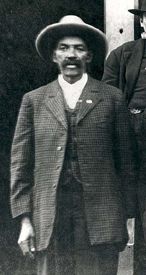
Bass Reeves, U.S. Deputy Marshal.
An imposing figure, always riding on a large white stallion, Reeves began to earn a reputation for his courage and success at bringing in or killing many desperadoes of the territory. Always wearing a large hat, Reeves was usually a spiffy dresser, with his boots polished to a gleaming shine. He was known for his politeness and courteous manner. However, when the purpose served him, he was a master of disguises and often utilized aliases.
Sometimes appearing as a cowboy, farmer, gunslinger, or outlaw himself, he always wore two Colt pistols, butt forward for a fast draw. Ambidextrous, he rarely missed his mark.
Leaving Fort Smith, often with a pocketful of warrants, Reeves would return months later, herding several outlaws charged with crimes ranging from bootlegging to murder. Paid in fees and rewards, he would make a handsome profit before spending a little time with his family and returning to the range.
The stories of his captures are legendary, filled with intrigue, imagination, and courage. On one occasion, Reeves pursued two outlaws in the Red River Valley near the Texas border. Gathering a posse, he and the other men set up camp about 28 miles from where the outlaws were believed to be hiding at their mother’s home. After studying the terrain and devising a plan, Reeves disguised himself as a tramp, concealing his tools of the trade—handcuffs, pistol, and badge—under his clothing. Setting out on foot, he arrived at the house wearing worn shoes, dirty clothes, and carrying a cane, topped off with a floppy hat that had three bullet holes.
Upon arriving at the home, he told the woman who answered the door that his feet were aching after having been pursued by a posse who had put three bullet holes in his hat. After asking for a bite to eat, she invited him in, and while he was eating, she began to tell him of her two young outlaw sons, suggesting that the three of them should join forces.
Feigning weariness, she consented to let him stay a while longer. As the sun set, Reeves heard a sharp whistle coming from beyond the house. Shortly afterward, the woman went outside and responded with an answering whistle. Before long, two riders rode up to the house, talking at length with her outside. The three came inside, and she introduced her sons to Reeves. After discussing their crimes, the trio agreed that joining would be a good idea.
Bunking down in the same room, Reeves observed the pair as they drifted off to sleep and, when they were snoring deeply, handcuffed the pair without waking them. When early morning approached, he kicked the boys awake and marched them out the door. Followed for the first three miles by their mother, who cursed Reeves the entire time, he marched the pair 28 miles to the camp where the posse men waited. The outlaws were delivered to the authorities within days, and Bass collected a $5,000 reward.
One of the high points of Reeves’ career was apprehending a notorious outlaw, Bob Dozier. Dozier was known as a jack-of-all-trades when it came to committing crimes, as they covered a wide range from cattle and horse rustling to holding up banks, stores, and stagecoaches to murder and land swindles. Because Dozier was unpredictable, he was also hard to catch, and though many lawmen had tried to apprehend him, none were successful until it came to Reeves. Dozier eluded Reeves for several months until the lawman tracked him down in the Cherokee Nation. After refusing to surrender, Reeves killed Dozier in an accompanying gunfight on December 20, 1878.
In 1887, Reeves was charged with murdering a posse cook. Like the many outlaws he had arrested, he was tried before Judge Isaac Parker. United States Attorney W.H.H. Clayton, a colleague and friend, represented him. In the end, Reeves was acquitted.
In 1889, after Reeves was assigned to Paris, Texas, he went after the Tom Story gang of horse thieves. He waited along the route that the gang was known to have used and surprised Tom Story with an arrest warrant. The outlaw panicked and drew his gun, but Reeves drew faster and shot him dead. The rest of the gang disbanded and were never heard from again.

Legends of America founder Kathy Weiser-Alexander discusses Bass Reeves in the series “True First” on UMC (Urban Movie Channel), March 2019
In 1890, Reeves arrested a notorious Seminole outlaw named Greenleaf, who had murdered seven people and had been on the run for 18 years. The same year, Reeves went after the famous Cherokee outlaw Ned Christie. Reeves and his posse burned Christie’s cabin, but he eluded capture.
In 1896, Reeves’ wife died in Fort Smith, and the following year, he was transferred to the Muskogee federal court in Indian Territory. In 1900, he married Winnie Sumter for the second time.
The tales of Reeves’ heroics are numerous and varied, but one of the toughest challenges he faced as a lawman was the manhunt for his son in 1902. After delivering two prisoners to U.S. Marshal Leo Bennett in Muskogee, Oklahoma, Reeves received bad news. His son, Bennie, had been charged with murder for killing his wife in a fit of jealousy. Although the warrant had been sitting on Bennett’s desk for two days, the other deputies were reluctant to act. Despite being shaken by the situation, Reeves insisted on taking responsibility for finding his son. Two weeks later, Reeves returned to Muskogee with Bennie in custody and turned him over to Marshal Bennett. Bennie was tried and convicted to life in prison, subsequently being sent to Leavenworth Penitentiary in Kansas. Later, through a citizen’s petition and an exemplary record in prison, Bennie Reeves was pardoned and lived the rest of his life as a model citizen.
“Reeves was never known to show the slightest excitement under any circumstance. He does not know what fear is.”
– Oklahoma City Weekly Times-Journal
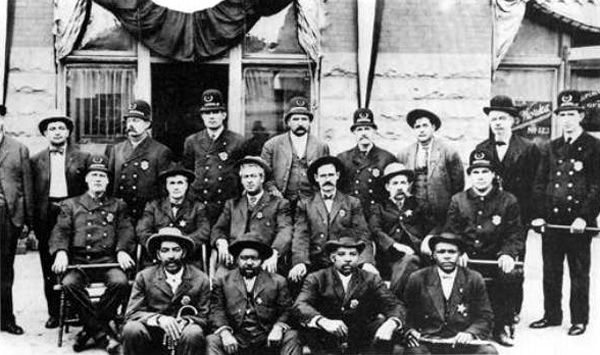
Muskogee Oklahoma Policemen with Bass Reeves in the front row with a cane.
In 1907, state agencies assumed law enforcement, and Reeves’ duties as a deputy marshal ended. Next, Bass was a patrolman with the Muskogee, Oklahoma Police Department. During the two years he served in this capacity, there were reportedly no crimes on his beat. Reeves’ diagnosis with Bright’s disease finally ended his career when he took to his sickbed in 1909. He died on January 12, 1910, and was buried in the Agency Cemetery at Muskogee, Oklahoma, but the exact location of his grave is unknown. According to Find a Grave, it is on private property and unmarked.
This universally respected man’s lengthy and glowing obituary described him as “absolutely fearless and knowing no master but duty.”
Over the 35 years that Bass Reeves served as a Deputy United States Marshal, he earned his place in history by being one of the most effective lawmen in Indian Territory, bringing in more than 3,000 outlaws and helping to tame the lawless territory. Killing some 14 men during his service, Reeves always said that he “never shot a man when it was not necessary for him to do so in the discharge of his duty to save his own life.”
Many argue, including Bill O’Reilly’s Legends & Lies 2015 television series, that there is evidence that Bass Reeves was the basis of the now-classic radio and later television series “The Lone Ranger,” with several key similarities between the character and the actual legend. However, that claim is debated by others. We tend to believe he was the ‘Lone Ranger.
“Eighty miles west of Fort Smith was known as “the deadline,” and whenever a deputy marshal from Fort Smith or Paris, Texas, crossed the Missouri, Kansas & Texas track, he took his own life in his hands, and he knew it. On nearly every trail would be found posted by outlaws, a small card warning certain deputies that if they ever crossed the deadline, they would be killed. Reeves has a dozen of these cards, which were posted for his special benefit. And in those days, such a notice was no idle boast and many an outlaw has bitten the dust trying to ambush a deputy on these trails.”
— Oklahoma City newspaper article, 1907
©Kathy Alexander/Legends of America, updated January 2025.
Also See:
Bob Dozier – Killed at the hands of Bass Reeves
Isaac C. Parker – Hanging Judge of Indian Territory
Old West Lawmen & Gunfighters Photo Print Gallery
U.S. Marshals – Two Centuries of Bravery
Sources:
Burton, Art T.; Black Gun, Silver Star: The Life and Legend of Frontier Marshal Bass Reeves; Bison Books, 2008
Encyclopedia of Arkansas
History.com
Wikipedia

